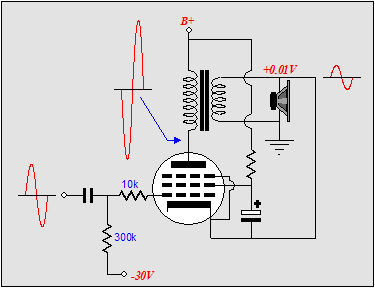Hello guys, Ive found this circuit on the web. What do you think about it?
 It has 100% degenerative fedback which will extend frequency response and maybe make the bass control better. But do someone have some personal experience with this circuit? I can build it with 6P15P russian output tube.
It has 100% degenerative fedback which will extend frequency response and maybe make the bass control better. But do someone have some personal experience with this circuit? I can build it with 6P15P russian output tube.
I played all my life on single ended triode amplifiers with no feedback. Im a little bit scared that this circuit will be too accurate and flat sounding...
I have no idea how this can sound.
But for example regular cathode follower also is 100% degenerative feedback and this play in my system very good.
Now I have a 2W 45 SET amplifier.
Thank you for replies. Michal

I played all my life on single ended triode amplifiers with no feedback. Im a little bit scared that this circuit will be too accurate and flat sounding...
I have no idea how this can sound.
But for example regular cathode follower also is 100% degenerative feedback and this play in my system very good.
Now I have a 2W 45 SET amplifier.
Thank you for replies. Michal
The damping factor is relatively low. If you use a very high gm as EL84 loaded 6k, the damping factor is about 2.
Last edited:
It's an idea, not really a circuit. To quote from the website where you got it:
"In the schematic above, we see a power pentode configured in a simple single-ended topology, with the only interesting twist being the pentode’s cathode direct connection to the transformer’s secondary. This connection eliminates the pentode functioning as an amplifier, as the cathode follows the grid, thus providing 100% degenerative feedback."
I completely disagree that there will be 100% degenerative feedback. You could certainly lash such a circuit together on a piece of plywood to see how well it works in practice.
"In the schematic above, we see a power pentode configured in a simple single-ended topology, with the only interesting twist being the pentode’s cathode direct connection to the transformer’s secondary. This connection eliminates the pentode functioning as an amplifier, as the cathode follows the grid, thus providing 100% degenerative feedback."
I completely disagree that there will be 100% degenerative feedback. You could certainly lash such a circuit together on a piece of plywood to see how well it works in practice.
I agree with audiowize — I also find questionable that the circuit is 100% degenerate in feedback. Given the –30 V fixed grid bias, and an unknown but likely 5000 : 8 Ω (25 : 1 step-down) of the output transformer, A ±5 V signal with a gain of 5 or so, give ±25 V anode swing, resulting in ±1 V output terminal swing. ±1 V on top of ±5 V input (degenerating it to effectively ±4 V) still leaves it with gain. Reduced gain, to be sure. Gain notwithstanding.
These aren't formal calculations of course. Just the seat-of-the-pants kind that give strong hints whether alleged characteristics, are borne out in fact
⋅-⋅-⋅ Just saying, ⋅-⋅-⋅
⋅-=≡ GoatGuy ✓ ≡=-⋅
These aren't formal calculations of course. Just the seat-of-the-pants kind that give strong hints whether alleged characteristics, are borne out in fact
⋅-⋅-⋅ Just saying, ⋅-⋅-⋅
⋅-=≡ GoatGuy ✓ ≡=-⋅
I think Broskie was probably thinking that one would just specify a suitable cathode feedback winding (or look for a 5K transformer with maybe a 600 ohm tap?), but didn't bother taking the time to draw it.
It is not 100% feedback since the OPT's ratio is not 1:1. I use a similar approach for the output stage in the Tubelab SSE amp. I use a blocking cap to keep the DC out of the OPT. Some sensitive speakers don't like 10 mV across them. Several hundred have been built over 14 years.
The cathode feedback can be used, disabled, or switchable. The amp can be wired for triode, pentode, or UL. Virtually nobody uses pentode operation, but UL with cathode feedback is a popular connection.
The UL mode provides nearly as much power output as pentode mode. Adding cathode feedback gets the damping factor up to almost that of a triode without killing the power output.
The schematic is attached.
The cathode feedback can be used, disabled, or switchable. The amp can be wired for triode, pentode, or UL. Virtually nobody uses pentode operation, but UL with cathode feedback is a popular connection.
The UL mode provides nearly as much power output as pentode mode. Adding cathode feedback gets the damping factor up to almost that of a triode without killing the power output.
The schematic is attached.